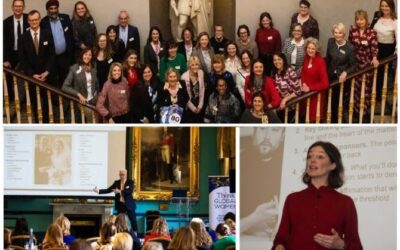Mental wellbeing in construction and engineering workplaces
The construction and engineering industry gathered to tackle mental health at work during October’s MAD World Construction Summit. The conversation reinforced the need for bottom-up as well as top-down approaches.
Three out of five UK employees experience mental health issues because of work, according to workforce mental health charity, Mates in Mind. Yet, 68% of managers believe there are barriers to providing mental wellbeing support for those they manage.
During a series of panels, speakers from across industry shared their success stories as well as lessons learnt. Steve Hails, director of business services and health, safety and wellbeing at Tideway London, began by discussing the role of strong leadership and buy-in from the top when it comes to prioritising mental wellbeing in the workplace.
He noted that mental wellbeing must be upheld as an organisational value and priority in order for it to trickle down in any meaningful way; reiterating that a happy workforce, makes a productive and efficient organisation with a healthy bottom line.
When it comes to building wellbeing initiatives that work, Steve Hails warned of the need to ensure the right ideas go forward and not be tempted to simply take a top-down approach.
“Reach into your workforce and actively listen to their ideas, experiences and expertise. When you do, you’ll find some real nuggets there and discover the solutions that will really make a difference to your workforce.”
In it together
He also urged companies to connect with different identities and shared the impact of the Tideway Mental Health Working Group (Tideway Tribes). This is an initiative that creates safe spaces for employees to share their experiences, find common ground and work through their challenges together.
Tideway Tribes was established to support different groups, many with their own unique challenges, and was particularly necessary during the height of the pandemic. It helped those struggling with working from home, single parents, those acting as carers or living alone.
“We wanted things to be different with Tideway Tribes. We invested in our welfare and wanted it to be truly transformational.”
The panel illustrated how simple changes that might not commonly be viewed as mental health or wellbeing have a significant impact on employee wellbeing. For instance, having all staff go through the same door to break down silos and building showers and facilities to a high standard to show workers are respected and considered.
Panellists shared a range of initiatives and their experiences providing mental health provision, from organisational changes to individual interventions.“You have to understand the groups you’re trying to support and the environment they work in before putting any interventions in place,” said Kris Kelly, head of HSEQ and support services at ADT Workplace.
“Don’t assume one solution fits all and try to always have alternative options in place. If someone feels uncomfortable to speak to a mental health first aider, they may appreciate an anonymous text service instead.”
He added that for many organisations, cost, energy and resources remain concerns, but demonstrated that the cost of mental wellbeing initiatives can be minimal and equally impactful.
“We have a mental health lunch, where employees bring a butty and chat. There are lots of free and low-cost initiatives, so businesses don’t have to fear it being a financial burden. Empowering your most passionate employee advocates can be helpful to help drive change, too. For anyone who pays the CITB levy, there is also funding available through the employee network for mental health first aid support.”
Reaping the results
Joanne Pigram FCIM, head of marketing and social value at Danaher & Walsh Group Ltd, shared her journey in improving the company’s mental wellbeing offering.
“Soon after joining the business I went to my first Mental Health Committee (MHC) meeting. I remember feeling quite frustrated with the typical bake-sale ideas. We have a very flat and direct structure, so I suggested to my director that I take over the MHC and they were delighted. There was already buy-in, but nobody to drive it. The first thing I did was join Mates in Mind. What really inspired me about Mates in Mind is that you do an assessment. That became the basis of our plan. It tells you where you are now and helps you get where you want to be, like a route map.”
The road to improvement involved several steps. “We sent out employee surveys to collect feedback anonymously and understand how people were feeling. We updated our policies, ran lots of comms, health and safety reporting, and ran different initiatives at speed. In our first survey, seven months later, 14% of the organisation said they were dissatisfied or very dissatisfied with the mental health provision. By the second survey, that was down to 1%.”She acknowledged that while some mental wellbeing initiatives have been successful, encouraging participation can be hard. It requires consistency, adaptability and creativity. “People like to be thanked, but sometimes forget to do the same for others, so we now run appreciation Fridays.”
Inclusive approaches
Marc Preston, managing director of Vertice Development Management Limited and CEO of New Foundation Counselling, talked about inclusion as a key factor in mental wellbeing provision. “It’s important that people of various identities feel included and belong.” He spoke of the need for clear and supportive language as a sector with employees from a range of cultural identities and said the same considerations should apply to all different groups of people.“As an industry, we’re always talking about getting more women into construction and engineering, so we need to cater to them in all areas of the business if we are really serious about women entering the workforce.”He cited the value of seemingly small things that contribute to overall wellbeing, like ensuring menstrual hygiene products are available at work site toilets. Then he shared the value of lunchtime talks that educate and support employees on challenging topics and gave an example of a session with 30 construction employees on body image.Joanne Pigram went on to talk about the potential benefits of a diverse workforce in influencing the quality of wellbeing initiatives. “At Danaher & Walsh Group, we have women in key roles, from site agents to surveyors and supply chain managers. We’ve got a high percentage of women in leadership too, punching above our weight in terms of our wellbeing initiatives and I don’t think that’s unrelated to the amount of women we have in leadership.”In a later panel, Danny Clarke, head of engagement at the Construction Industry Training Board (CITB), also stressed the need for mental wellbeing initiatives to factor in neurodivergent conditions, stating that one in three people in construction identify as neurodivergent.
Normalising mental wellbeing
Luke Mason-Hobbs, social value consultant at Mott MacDonald, shared how the company is focused on helping apprentices and young new entrants deal with new work and behaviour norms, which can take a mental toll.
While Logan Price, quantity surveying degree and construction mental health ambassador at MPB Structures, shared his challenges of going through an apprenticeship and entering the workforce for the first time.
“Entry does not define you in construction, but the transition from education to the workplace can be hard for many. We need to explore how to make that transition better. When I first went into industry I didn’t have full support around me at 17. I’m 22 now, but at the time, it seemed unfathomable to say, ‘I’m struggling’. Long hours and knowing what’s normal and what’s not were hard,” he added.
Despite progress, stigma remains a large barrier to accessing employee mental wellbeing provisions in the construction and engineering industry.
Most of the audience and panel agreed ‘physical health and injury’ is still perceived differently and treated with more urgency than mental health.
“There are barriers, but you have to chip away at them by creating safe spaces to talk,” said Joanne Pigram. I go out on-site regularly and ask people how they are. Every morning briefing on the agenda we have a wellbeing check-in. Everyone gives a quick score on how they’re feeling. If there’s a cause for concern, that’s then followed up by a manager or referred to the MHC. Little adjustments can help to normalise conversations about mental health.”
Did you know?
Over two thirds of employees in the construction and surveying profession believe there is a stigma surrounding mental health which stops them talking about it.
Number crunch
£51 billion – the cost of mental health to UK employers£4.70 – the average return on investment for every £1 employers spend on employee mental health and wellbeing through increased productivity
Source: Deloitte







